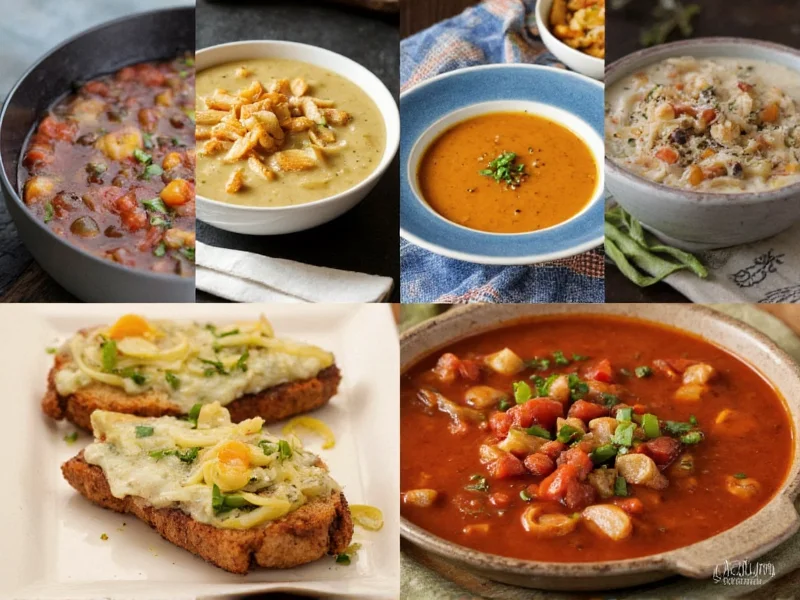When summer temperatures rise, cold soups become essential kitchen staples that combine nutrition with refreshment. Unlike hot soups requiring lengthy cooking, these chilled creations maximize seasonal produce while preserving nutrients through raw preparation. The best cold soups balance acidity, texture, and temperature to create satisfying meals that cool without compromising flavor complexity.
The Global Tradition of Chilled Soups
Cold soups aren't just a modern convenience—they represent centuries of culinary adaptation to warm climates. Mediterranean cultures developed vegetable-based options like gazpacho to utilize abundant summer produce, while Eastern European traditions created beet-based chilled borscht for both refreshment and preservation. Understanding these cultural roots helps recreate authentic flavors while inspiring new variations.
| Soup Variety | Origin | Key Ingredients | Prep Time |
|---|---|---|---|
| Gazpacho | Spain | Tomatoes, cucumber, bell pepper, garlic, olive oil | 20 minutes |
| Vichyssoise | France | Potatoes, leeks, cream, chicken stock | 15 minutes + chilling |
| Tarator | Bulgaria | Cucumber, walnuts, garlic, yogurt | 10 minutes |
| Ajoblanco | Spain | Almonds, garlic, bread, olive oil | 25 minutes |
| Chilled Cucumber | Global | Cucumber, dill, Greek yogurt, mint | 15 minutes |
Essential Techniques for Perfect Cold Soups
Successful cold soup preparation requires specific techniques that differ from hot soup making. Temperature control proves critical—soups should chill for at least four hours but not exceed 24 hours to maintain freshness. When blending vegetable-based soups, add liquid gradually to achieve silky textures without diluting flavors. For cream-based options like vichyssoise, use full-fat dairy alternatives for better emulsion stability when chilled.
Seasoning demands special attention since cold temperatures mute flavors. Add salt incrementally after chilling, as required amounts typically increase by 25-30% compared to hot preparations. Acid components like lemon juice or vinegar should be added just before serving to maintain brightness. Garnishes serve dual purposes in cold soups—they provide textural contrast against smooth bases and add visual appeal that stimulates appetite.
Refreshing Cold Soup Recipes to Try
For effortless summer dining, start with a basic gazpacho formula: combine 2 pounds ripe tomatoes, 1 cucumber, 1 red bell pepper, 1/2 red onion, 2 garlic cloves, 3 tablespoons olive oil, and 2 tablespoons sherry vinegar. Blend until smooth, then chill for four hours. This foundational recipe welcomes endless variations—add watermelon for sweetness, avocado for creaminess, or serrano peppers for heat.
Those seeking dairy-free creamy options should try ajo blanco, the almond-based Spanish classic. Soak 1 cup blanched almonds for two hours, then blend with 2 cups stale bread (crusts removed), 4 garlic cloves, 1 cup olive oil, and 1 cup water. The result delivers luxurious texture without dairy while providing plant-based protein. Serve with green grapes for contrasting sweetness and texture.
Serving and Storage Guidelines
Proper presentation elevates cold soups from simple refreshments to elegant courses. Always serve in pre-chilled bowls—room temperature vessels quickly warm the soup. Consider texture contrasts: crunchy croutons, toasted seeds, or fresh herb oils complement smooth bases. For entertaining, portion soups into shot glasses or martini glasses for elegant appetizers.
Storage requires careful attention to food safety. Most vegetable-based cold soups maintain quality for 3-4 days refrigerated in airtight containers. Cream-based versions last 2-3 days due to dairy content. Never freeze cold soups intended for immediate consumption, as texture changes significantly upon thawing. When preparing make-ahead batches, keep garnishes separate until serving to maintain freshness and crunch.
Adapting Cold Soups for Dietary Needs
These versatile recipes accommodate various dietary requirements with simple substitutions. For vegan versions, replace dairy with coconut milk or cashew cream. Gluten-free adaptations work seamlessly by using gluten-free bread or omitting bread entirely. Low-sodium variations substitute herb-infused waters for stock components while maintaining depth of flavor.
Those managing blood sugar find cold soups particularly beneficial. Vegetable-based options typically contain 10-15 grams of natural sugars per serving, with high fiber content that slows absorption. The hydration factor also supports metabolic function during hot weather when dehydration can impact blood sugar regulation. Adding protein sources like white beans or Greek yogurt creates more balanced meals suitable for diabetes management.











 浙公网安备
33010002000092号
浙公网安备
33010002000092号 浙B2-20120091-4
浙B2-20120091-4